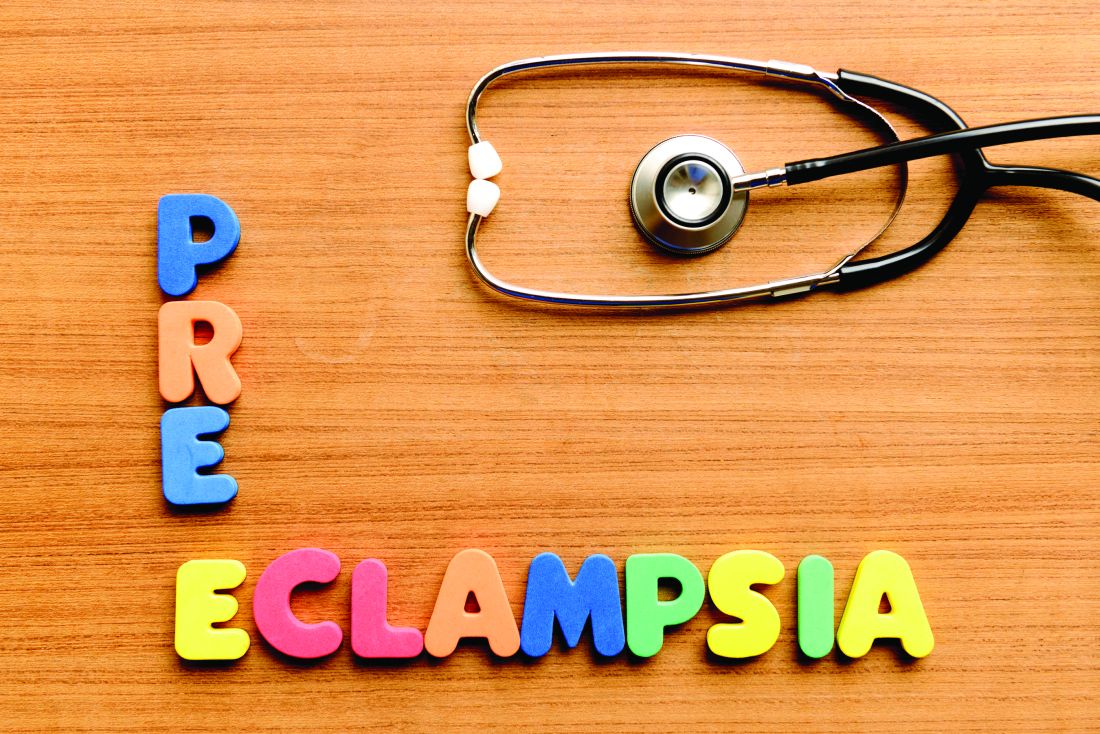User login
The cost of medical care for preeclampsia is estimated to be $2.18 billion for the first year surrounding delivery, split almost evenly between care for mothers and infants, according to a new report.
Preeclampsia is increasing at a more rapid rate than diabetes, ischemic heart failure, Alzheimer’s disease, obesity, and chronic kidney disease – disorders for which substantially more funding has been allocated for research and treatment, said Warren Stevens, PhD, of Precision Health Economics, Los Angeles, and his associates. Precision Health Economics provides consulting and other research services to pharmaceutical, device, government, and nongovernmental groups.
Compared with a healthy pregnancy, preeclampsia increased the probability that a mother would have at least one adverse outcome from 4.6% to 10.1%, and it increased the probability that an infant would have at least one adverse outcome from 7.9% to 14.2%. For mothers, preeclampsia was estimated to raise costs by $6,583 per birth, which translates to an increase of $1.03 billion for U.S. mothers during a single year (2012). For infants, the disorder raised costs by $1.15 billion during that year.
Infant costs varied according to the gestational age at delivery, ranging from $1,311 per birth at 36 weeks’ gestation to $150,000 per birth at 26 weeks’ gestation, Dr. Stevens and his associates reported (Am J Obstet Gynecol. 2017 Jul 11. doi: 10.1016/j.ajog.2017.04.032).
This study could not take into account longer-term adverse outcomes associated with preeclampsia. Women with a history of the disorder are at double the risk of developing ischemic heart disease or cerebrovascular disease compared with women without such a history, and at three times the risk of developing hypertension. Infants are at increased risk of developing stroke, metabolic syndrome, and chronic heart disease, the investigators noted.
The study was supported by rEVO Biologics. Five of the study authors are employees of rEVO Biologics and one author is a steering committee member for a clinical trial supported by the company; another study author is a consultant at Precision Health Economics.
Quantifying the total cost of a health problem helps to show the public, payers, and health care administrators the magnitude of the problem on a population level. By underscoring the economic burden of preeclampsia, Stevens et al. provided important information about the high costs of this condition.
However, we need to go beyond health burden and cost-of-illness studies when considering the value of interventions to prevent and better manage preeclampsia and its adverse outcomes. Cost of the intervention and the cost savings associated with preventing one case of the condition are important parameters that can be used to calculate the potential savings of interventions. In fact, if the lifetimes costs of caring for children with adverse outcomes of preeclampsia are included, the potential cost savings from effective interventions may be even greater.
Rui Li, PhD, and William M. Callaghan, MD, are in the division of reproductive health at the Centers for Disease Control and Prevention, Atlanta. Eleni Tsigas is with the Preeclampsia Foundation in Melbourne, Fla. They reported having no relevant financial disclosures. These remarks are adapted from an editorial (Am J Obstet Gynecol. 2017 Jul 11. doi: 10.1016/j.ajog.2017.06.011).
Quantifying the total cost of a health problem helps to show the public, payers, and health care administrators the magnitude of the problem on a population level. By underscoring the economic burden of preeclampsia, Stevens et al. provided important information about the high costs of this condition.
However, we need to go beyond health burden and cost-of-illness studies when considering the value of interventions to prevent and better manage preeclampsia and its adverse outcomes. Cost of the intervention and the cost savings associated with preventing one case of the condition are important parameters that can be used to calculate the potential savings of interventions. In fact, if the lifetimes costs of caring for children with adverse outcomes of preeclampsia are included, the potential cost savings from effective interventions may be even greater.
Rui Li, PhD, and William M. Callaghan, MD, are in the division of reproductive health at the Centers for Disease Control and Prevention, Atlanta. Eleni Tsigas is with the Preeclampsia Foundation in Melbourne, Fla. They reported having no relevant financial disclosures. These remarks are adapted from an editorial (Am J Obstet Gynecol. 2017 Jul 11. doi: 10.1016/j.ajog.2017.06.011).
Quantifying the total cost of a health problem helps to show the public, payers, and health care administrators the magnitude of the problem on a population level. By underscoring the economic burden of preeclampsia, Stevens et al. provided important information about the high costs of this condition.
However, we need to go beyond health burden and cost-of-illness studies when considering the value of interventions to prevent and better manage preeclampsia and its adverse outcomes. Cost of the intervention and the cost savings associated with preventing one case of the condition are important parameters that can be used to calculate the potential savings of interventions. In fact, if the lifetimes costs of caring for children with adverse outcomes of preeclampsia are included, the potential cost savings from effective interventions may be even greater.
Rui Li, PhD, and William M. Callaghan, MD, are in the division of reproductive health at the Centers for Disease Control and Prevention, Atlanta. Eleni Tsigas is with the Preeclampsia Foundation in Melbourne, Fla. They reported having no relevant financial disclosures. These remarks are adapted from an editorial (Am J Obstet Gynecol. 2017 Jul 11. doi: 10.1016/j.ajog.2017.06.011).
The cost of medical care for preeclampsia is estimated to be $2.18 billion for the first year surrounding delivery, split almost evenly between care for mothers and infants, according to a new report.
Preeclampsia is increasing at a more rapid rate than diabetes, ischemic heart failure, Alzheimer’s disease, obesity, and chronic kidney disease – disorders for which substantially more funding has been allocated for research and treatment, said Warren Stevens, PhD, of Precision Health Economics, Los Angeles, and his associates. Precision Health Economics provides consulting and other research services to pharmaceutical, device, government, and nongovernmental groups.
Compared with a healthy pregnancy, preeclampsia increased the probability that a mother would have at least one adverse outcome from 4.6% to 10.1%, and it increased the probability that an infant would have at least one adverse outcome from 7.9% to 14.2%. For mothers, preeclampsia was estimated to raise costs by $6,583 per birth, which translates to an increase of $1.03 billion for U.S. mothers during a single year (2012). For infants, the disorder raised costs by $1.15 billion during that year.
Infant costs varied according to the gestational age at delivery, ranging from $1,311 per birth at 36 weeks’ gestation to $150,000 per birth at 26 weeks’ gestation, Dr. Stevens and his associates reported (Am J Obstet Gynecol. 2017 Jul 11. doi: 10.1016/j.ajog.2017.04.032).
This study could not take into account longer-term adverse outcomes associated with preeclampsia. Women with a history of the disorder are at double the risk of developing ischemic heart disease or cerebrovascular disease compared with women without such a history, and at three times the risk of developing hypertension. Infants are at increased risk of developing stroke, metabolic syndrome, and chronic heart disease, the investigators noted.
The study was supported by rEVO Biologics. Five of the study authors are employees of rEVO Biologics and one author is a steering committee member for a clinical trial supported by the company; another study author is a consultant at Precision Health Economics.
The cost of medical care for preeclampsia is estimated to be $2.18 billion for the first year surrounding delivery, split almost evenly between care for mothers and infants, according to a new report.
Preeclampsia is increasing at a more rapid rate than diabetes, ischemic heart failure, Alzheimer’s disease, obesity, and chronic kidney disease – disorders for which substantially more funding has been allocated for research and treatment, said Warren Stevens, PhD, of Precision Health Economics, Los Angeles, and his associates. Precision Health Economics provides consulting and other research services to pharmaceutical, device, government, and nongovernmental groups.
Compared with a healthy pregnancy, preeclampsia increased the probability that a mother would have at least one adverse outcome from 4.6% to 10.1%, and it increased the probability that an infant would have at least one adverse outcome from 7.9% to 14.2%. For mothers, preeclampsia was estimated to raise costs by $6,583 per birth, which translates to an increase of $1.03 billion for U.S. mothers during a single year (2012). For infants, the disorder raised costs by $1.15 billion during that year.
Infant costs varied according to the gestational age at delivery, ranging from $1,311 per birth at 36 weeks’ gestation to $150,000 per birth at 26 weeks’ gestation, Dr. Stevens and his associates reported (Am J Obstet Gynecol. 2017 Jul 11. doi: 10.1016/j.ajog.2017.04.032).
This study could not take into account longer-term adverse outcomes associated with preeclampsia. Women with a history of the disorder are at double the risk of developing ischemic heart disease or cerebrovascular disease compared with women without such a history, and at three times the risk of developing hypertension. Infants are at increased risk of developing stroke, metabolic syndrome, and chronic heart disease, the investigators noted.
The study was supported by rEVO Biologics. Five of the study authors are employees of rEVO Biologics and one author is a steering committee member for a clinical trial supported by the company; another study author is a consultant at Precision Health Economics.
FROM THE AMERICAN JOURNAL OF OBSTETRICS & GYNECOLOGY
Key clinical point:
Major finding: Compared with healthy pregnancy, preeclampsia increased the probability that a mother would have at least one adverse outcome from 4.6% to 10.1%, and it increased the probability that an infant would have at least one adverse outcome from 7.9% to 14.2%.
Data source: A retrospective cohort study using secondary analysis of numerous data sets and extrapolating from approximately 2 million births in 2012 (1,918,498 births without preeclampsia and 69,193 with preeclampsia).
Disclosures: The study was supported by rEVO Biologics. Five of the study authors are employees of Precision Health Economics and one author is a consultant there; another author is on the steering committee for a clinical trial supported by rEVO Biologics.

